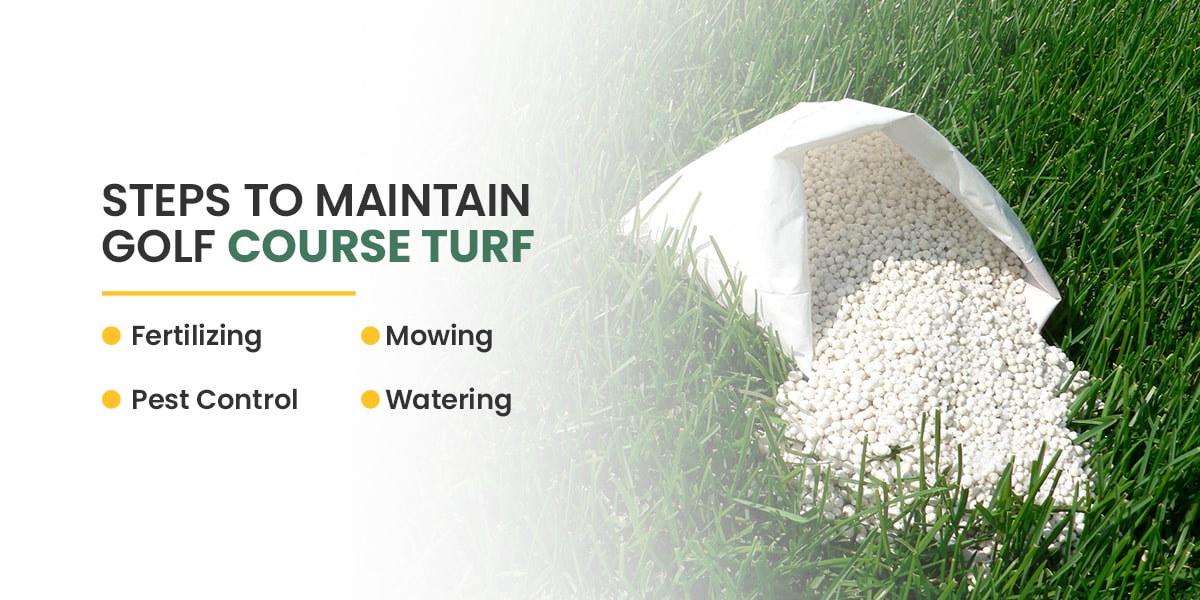
Golf courses require regular maintenance that depends on the climate and the time of year. There is a lot of work to do, but putting in the effort will provide golfers with a better experience and a smoother game, keeping them coming back to your course.
What Kind of Turf Do Golf Courses Use?
Throughout a golf course, there are several different grass species and turf to keep the quality of play consistent across different parts of the course. Each area is also subject to various conditions, which change the type of turf used as well. Finally, the climate where the golf course is located will also affect the turf.
Here are some of the most common types of grass for golf courses:
Bermuda
Bermuda grass is often found on golf courses in warm weather climates. It is one of the more common golf course grasses as it can withstand heat, repairs quickly and is drought resistant. It can also be mowed very low, making it a common choice for tees, fairways and greens. Bermuda grass is used for the tees and fairways at the Augusta National, where the Masters Tournament is held in Georgia.
Bermuda grass shouldn’t be used in places where temperatures drop below 30 degrees.
Bentgrass
Bentgrass comes in several varieties and is best used in areas with moderate heat, such as the North, Mid-Atlantic, coastal California and the Midwest. Bentgrass can also be cut low, making it one of the top choices for greens and sometimes fairways. It is used on the greens at the Masters Tournament on the Augusta National course.
Perennial Ryegrass
Perennial ryegrass has been used on golf courses for a long time, most often in areas with moderate climates and cooler summers. In recent years, it has found its place in overseeding on top of Bermuda grass in tee boxes and fairways. Golf course maintenance crews have turned away from using it for a full turf because it tends to clump and must be heavily planted for hole-free terrain.
It comes in handy when Bermuda grass planted in colder climates dies back, as it can fill in the gaps. If used as a full section of turf, it is often for the rough grass areas where it does not need to be as smooth.
Zoysia
Zoysia is less climate-specific, making it a more common choice, especially for municipal courses. It holds its color well and can be mowed down to 3/4 of an inch. If zoysia grass is on a course, it will likely be found on the fairway.
Poa Annua
You are most likely to find poa annua grass on the West Coast, where they get plenty of rain. In other areas, the grass is seen as an invasive species but can create spectacular greens if managed appropriately and in the right climate. When used outside of the West Coast, the grass must be hand-watered consistently to survive due to its shallow roots.
Steps to Maintain Golf Course Turf
Golf course turf maintenance is a full-time job and requires a lot of equipment and attention to detail. You should pay attention to certain things to keep the turf you use in different areas in the best condition possible.
Fertilizing
It is important to fertilize your golf course, but doing so safely is often tricky. Chemical fertilizers, herbicides, growth regulators and plant stimulants are all necessary for the health of your golf course. You will need to care for the equipment you are using to fertilize your turf properly to avoid accidental exposure to any chemicals.
At CropCare®, we offer ATX Series sprayers designed for helping maintain large estates, just like golf courses. Our sprayers feature a high-quality spray gun with adjustable spray patterns so you can ensure you are spraying what you mean to spray.
Pest Control
Being outside, dealing with pests is inevitable. The best way to handle a pest problem is to take a preventative approach. Insecticides and pesticides are the tried and true way to keep your course free from pests. However, another method called integrated pest management (IPM) is also highly effective at managing pests. The technique uses pesticides along with a quality selection and care of turf.
Spraying your pesticides and insecticides can also be done with our ATX Series sprayers to keep your course safe and protected.
Mowing
Mowing your golf course is an essential part of the maintenance process. A well-mowed course will have a pleasing look and make the game more enjoyable for golfers. Different parts of the golf course will need to be mowed in different ways.
The tee boxes and the greens on a golf course should be mowed with a hand mower, as you want to cut the turf very low and precisely. The best time to tackle this task is right after a heavy rain. You should make sure you do it when your course is closed as it is time-consuming.
During the spring and fall, your grass should be mowed down to about 0.140 inches, while in the summer, you can go down to 0.100 inches while the grass is growing faster.
Watering
Watering your golf course is best done with an irrigation system to keep it even across the course. Technology allows you to automate irrigation systems and adjust them based on the rain. An irrigation system includes a water source, pumping station, distribution pumps and valves, control lines and sprinkler heads.
The only problem with an automated irrigation system is the wind factor, but watering early in the morning is usually a safe option and keeps the process from disrupting your golfers later in the day.
Fixing Divots
When golfers take a swing that slices the turf, there is often evidence left behind. Your goal is to make every golfer feel like they are the first to golf on the course, so regularly filling in divots is important. Leaving holes can also hinder play for golfers that follow.
To repair a divot, place the removed part of the turf back in the hole with the grass facing up and gently step on it. If that part was damaged, use a divot repair mix to fill in the hole.
Golf Course Turf Maintenance Schedule
Your golf course turf maintenance schedule will depend heavily on the type of soil, the climate you live in and other factors that are unique to your golf course. If your course closes in the winter, you will likely want to begin opening and caring for your turf in March as temperatures start to rise. Whenever you can, help your turf grow with things like lawn tonic. This will also help it grow back smoothly.
Throughout the winter, when people aren’t golfing, do what you can to keep your course healthy. Drain it and keep a close eye on it so you are aware of any issues and can begin taking care of them quickly.
Take Care of Your Course With CropCare®
At CropCare®, we strive to provide quality products that deliver the results you expect. Take your golf course turf maintenance techniques to the next level with our ATX sprayers.
Contact us with questions or to see how we can better serve you and your course.



